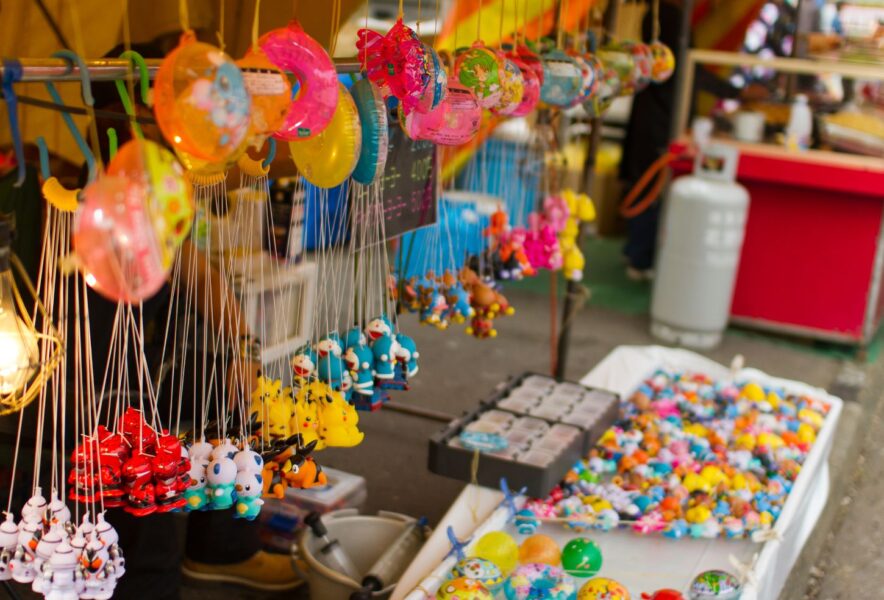Overview of Japanese Summer Festivals
Japanese summer festivals, or “matsuri,” are rich in tradition and reflect the unique characteristics of each region. Rooted in Shinto and Buddhist practices, these festivals have evolved into vibrant summer events celebrated across the country. The colorful fireworks, traditional dances, and delicious street food are hallmarks of the Japanese summer experience.
Major Summer Festivals in Tokyo
- Sumida River Fireworks Festival
When: Late July
Where: Along the Sumida River (Sumida and Taito wards)
Overview: One of Japan’s most famous fireworks festivals, the Sumida River Fireworks light up the night sky with about 20,000 fireworks. Spectators can enjoy the spectacular views from riverside seats or traditional yakatabune boats. For more information, visit the official website: Sumida River Fireworks Festival - Jingu Gaien Fireworks Festival
When: Mid-August
Where: Meiji Jingu Gaien (Shinjuku ward)
Overview: This large-scale fireworks festival in central Tokyo combines stunning fireworks with live concerts, creating an unforgettable summer evening. For more information, visit the official website: Jingu Gaien Fireworks Festival - Asakusa Samba Carnival
When: Late August
Where: Asakusa area
Overview: The Asakusa Samba Carnival is Japan’s largest samba parade, inspired by the Rio Carnival in Brazil. The vibrant costumes and energetic dances bring a lively and exotic atmosphere to the streets of Asakusa. For more information, visit the official website: Asakusa Samba Carnival - Mitama Matsuri at Yasukuni Shrine
When: Mid-July
Where: Yasukuni Shrine (Chiyoda ward)
Overview: Held every July, the Mitama Matsuri is a Bon festival at Yasukuni Shrine. Over 30,000 lanterns are lit, creating a mystical atmosphere, accompanied by traditional Bon dances and performances. For more information, visit the official website: Mitama Matsuri at Yasukuni Shrine - Kagurazaka Matsuri
When: Late July
Where: Kagurazaka (Shinjuku ward)
Overview: This festival transforms the charming streets of Kagurazaka into a vibrant celebration with traditional Bon dances and food stalls lining the narrow alleys. It’s a perfect opportunity to experience the local culture in a historic setting. For more information, visit the official website: Kagurazaka Matsuri - Fukagawa Hachiman Festival (Tomioka Hachimangu Shrine)
When: Mid-August
Where: Tomioka Hachimangu Shrine (Koto ward)
Overview: The Fukagawa Hachiman Festival is one of the Three Great Festivals of Edo, known for its unique “water throwing” ritual, where participants and onlookers splash water on the mikoshi (portable shrines) as they parade through the streets. For more information, visit the official website: Fukagawa Hachiman Festival
Highlights and How to Participate in Summer Festivals
The highlights of summer festivals include vibrant parades, traditional dances, and spectacular fireworks displays. If you’re planning to attend a festival, it’s essential to check the schedule and location beforehand. Popular festivals tend to be crowded, so it’s advisable to arrive early. Engaging with locals and participating in the festivities can provide a deeper cultural experience.
Food and Drinks to Enjoy at Summer Festivals
One of the joys of Japanese summer festivals is the variety of food and drinks available at the yatai (food stalls). Classic festival treats include takoyaki (octopus balls), yakisoba (fried noodles), taiyaki (fish-shaped pastries), and cotton candy. To cool down, enjoy a cold beer or a refreshing bottle of ramune, a traditional Japanese soda. Regional specialties are also often featured, offering a taste of local flavors.
Etiquette and Manners at Summer Festivals
When attending a summer festival, it’s important to be mindful of the people around you. Festivals can get crowded, so be considerate of others and avoid blocking pathways. Always dispose of trash properly, as cleanliness is highly valued in Japan. It’s also a good idea to carry cash, as many stalls may not accept credit cards, and use the restroom before the festival begins to avoid long lines.
Cultural Differences to Be Aware of When Participating
While Japanese summer festivals are exciting and culturally rich, there may be some cultural differences that visitors should be aware of. For example, you may encounter situations where it’s customary to remove your shoes, or you might notice that the rules of etiquette and manners are strictly followed. Understanding and respecting these differences will enhance your experience and help you immerse yourself fully in the festivities.
Conclusion
Japanese summer festivals offer a unique opportunity to connect with local culture and traditions. The lively atmosphere, delicious food, and engaging activities create unforgettable memories. By following local etiquette and embracing the experience, you can enjoy the full vibrancy of Japan’s summer festivals.

Comment